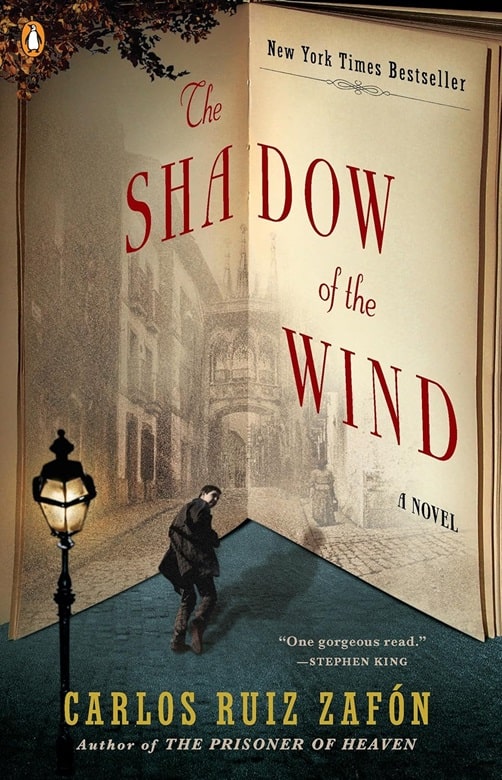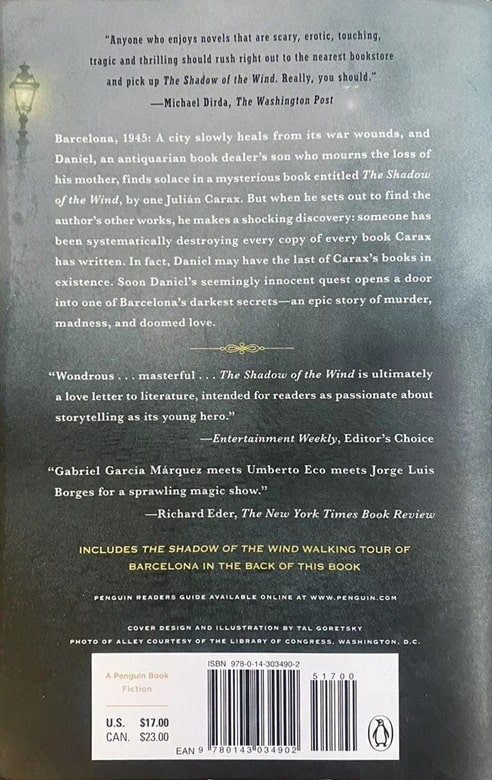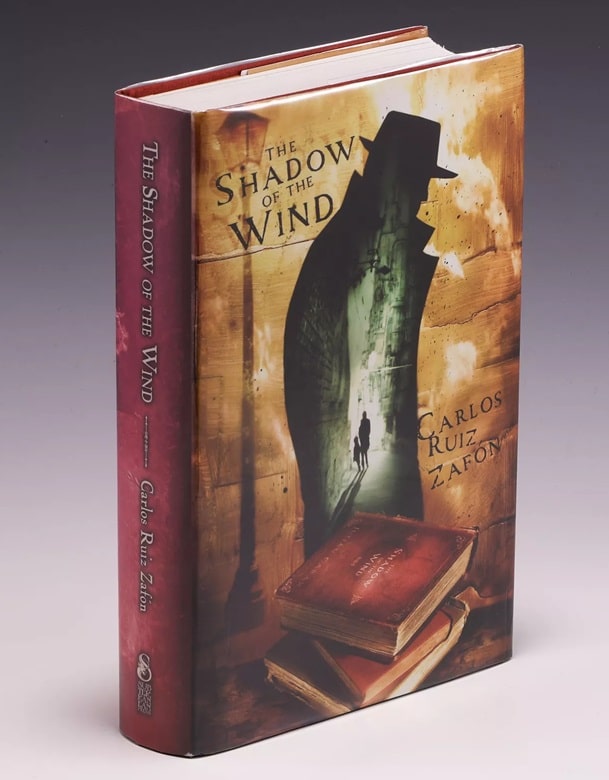Gothic Noir: The Shadow of the Wind by Carlos Ruiz Zafón
 |
 |
The Shadow of the Wind (Penguin Books, February 1, 2005). Cover by Tal Goretsky
Shadow of the Wind is the English rendering of La sombra del viento, the 2001 novel by Carlos Ruiz Zafón and the first (though a standalone story sans cliffhangers) in his five book Cemetery of Forgotten Books series, translated by Lucia Graves (a serendipitously appropriate last name and, as it happens, the daughter of poet and historical novelist Robert Graves, he of I Claudius and The White Goddess fame). I hope this is a literal translation as Shadow of the Wind perfectly captures the story’s gothic and noirish essence. We can’t actually see wind, nor does wind cast a shadow; rather we feel the wind, detecting by inference the sometimes destructive aftereffects of high winds. Or, to paraphrase as someone else famously put it, the allegory is blowing in the wind.
The titular Cemetery of Forgotten Books is a somewhat fantastical labyrinth repository of rare books. Unlike Julia Alvarez’s Cemetery of Untold Stories, where texts are buried and talk to one another in their afterlife, the Cemetery of Forgotten Books could be some idiosyncratic bookshop with obsessively weird stock accessible only to certain people, which is not that all different from certain kinds of booksellers.
But the touch of fantasy is when our hero, Daniel Sempere, taken to the Cemetery of Forgotten Books by his bookshop owning father, is tasked to select one volume, and one volume only, he feels drawn to from among a complex maze of shelvings. That book is Shadows of the Wind by Julian Carax, and, yes, we’re getting metafictional here. What kicks the plot off is that there are no other surviving copies of the work, Carax’s output having been destroyed in a warehouse fire of mysterious origins.
The Shadow of the Wind (Subterranean Press signed edition,
December 31, 2008). Cover by Vincent Chong
Of course, there’s nothing like the sole surviving copy of a book by a forgotten author to set off a Maltese Falcon chase, heavily seasoned by Daniel’s romantic entanglements that reflect Carax’s doomed love that led to his disappearance, along with a satanic-like character who bears an uncanny resemblance to a character in the book he is pursuing to take from Daniel. There are gruesome murders, eccentric characters, a hidden burial crypt, a priest, a corrupt and cruel police inspector with a subordinate officer of uncertain loyalties. Not to mention a number of booksellers. In other words, everything you’d expect from something like a black-and-white 1940s movie featuring Humphrey Bogart, Sydney Greenstreet, and Peter Lorre. And, of course, either Ingrid Bergman or Lauren Bacall. And fog. A lot of fog.
As Michael Dirda blurbs on the cover of my copy, the novel is “scary, erotic, touching, tragic, and thrilling.”
But, above all, this is a book about books and the people who love books. Not just read novels for entertainment. But because novels affect them viscerally in ways that are literally life-changing.
Which is why Zafón reportedly refused to sell the movie rights. A book about books couldn’t possibly become a movie.
Though apparently there was an attempt propose a film project.
Kind of makes Zafón’s point, doesn’t it?
David Soyka is one of the founding bloggers at Black Gate. He’s written over 200 articles for us since 2008. His most recent was a review of The Book of Elsewhere.

[…] latest Blackgate submission is this 2001 novel, first in the Cemetery of Forgotten Books […]